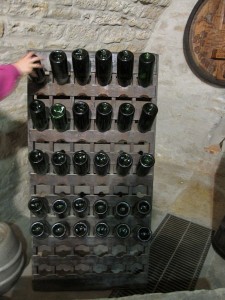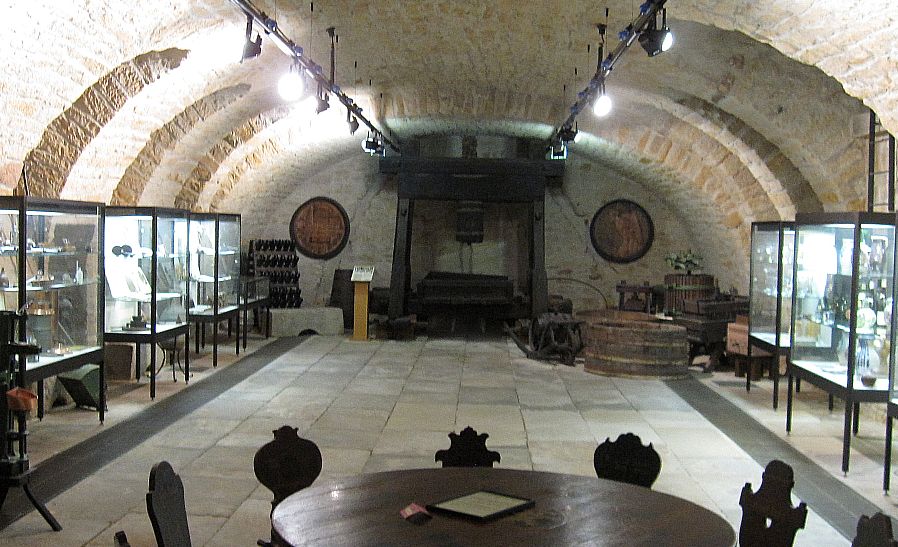When I visited the Pfalz region of Germany, I especially enjoyed the wines. The Rieslings are crisp, not cloying, the Spätburgunder is as fine as a good Pinot Noir, and the sparkling Sekt is equal in quality to French champagne.
 Wine-making is so ubiquitous to the culture and lifestyle of the Pfalz, the entire cellar of the Bad Dürkheim Heimatsmuseum is dedicated to a viticulture exhibit. The rack shown here is an example of the traditional method of fermenting champagne. According to the Heimatsmuseum curator, it was an iffy proposition — 10- to 20-percent of the bottles could be counted on to explode, the champagne wasted.
Wine-making is so ubiquitous to the culture and lifestyle of the Pfalz, the entire cellar of the Bad Dürkheim Heimatsmuseum is dedicated to a viticulture exhibit. The rack shown here is an example of the traditional method of fermenting champagne. According to the Heimatsmuseum curator, it was an iffy proposition — 10- to 20-percent of the bottles could be counted on to explode, the champagne wasted.
Wines from the Bad Dürkheim region were exported to Cleveland in the 19th century, thanks to the Dürkheimer wine-makers George and John Fitz and a Cleveland wine importer named Leick of Kirchheimbolanden. (Apparently Leick and his brother married the Hege sisters from Dürkheim, so a connection was made.)
In particular, the Fitz brothers produced the 1848 Dürkheimer Firemountain label especially for export. Records show the wine was also exported to New York City, Cleveland and New York City being areas with high Palatine immigrant populations. While the year on a label normally indicates the vintage, in this case, all wines carried this year. The year 1848 was a reference to the 1848 Revolution for democracy, the Fitz brothers reaching out in solidarity to exiles forced to immigrate to America after the revolution was crushed. It’s not clear how long the 1848 label lasted. But wine exports continued until Prohibition brought an end to the once lucrative trade.
These days, the Mosel region seems to dominate German wine imports to the U.S. However, I recently stumbled on a delightful surprise. The Fitz wine-makers of Bad Dürkheim are still in business. Now called the Fitz-Ritter Winery, the history of their revolutionary 19th century activities is even posted proudly on their website:
SEKT – SPARKLING WINE WITH DEMOCRATIC ROOTS
In 1837, the Fitz estate founded the first “Champagne“ Production in the Palatinate (second in all of Germany). Johannes Fitz, known as “the Red Fitz,” had imported the necessary know-how from the Champagne region of France which had been his exile home following his activity for the German Democracy movement at the Hambach Festival in 1832.
Five years later the first „Palatine Champagne“ emerged from the Bad Dürkheim winery. …Just as it was back then, today the Sektkellerei Fitz (Sekt is the German word for sparkling wine) still produces “Sekt” from Burgundy and Riesling wines by traditional bottle fermentation.
No wonder the Fitz wine-makers reached out to those suffering exile in 1848–John Fitz had been an exile himself in 1832. I checked into it, and the Fitz-Ritter wines are again being exported to the U.S. Oh happy day!

